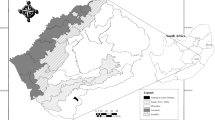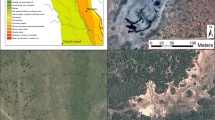Abstract
Arundinaria gigantea, or river cane, is a potential riparian buffer, and there is general interest in the restoration of the species to the southern Appalachian mountains. Proper classification of A. gigantea is critical in determining suitable candidate sites for planting. The 1988 National List of Plant Species That Occur in Wetlands lists A. gigantea as facultative wetland (FACW) for the southeast and elsewhere. In this article, we review plant, soil, and hydrologic data collected at 20 A. gigantea sites in western North Carolina, USA, and discuss the species wetland classification in light of our findings. Saturated hydraulic conductivity (K sat), bulk density (ρb), elemental abundance, soil description, plant identification, and hydrologic data are presented and suggest that river cane is currently classified incorrectly, and that an upland (UPL) or facultative upland (FACU) classification is more appropriate. None of the sites studied meet all 3 criteria common to wetland definitions (hydric soils, hydrophytic vegetation and wetland hydrology), although one of the sites had several wetland characteristics. We suggest that river cane restoration should occur in well drained, sandy soils and that the species should only be used as a riparian buffer in this type of setting.




Similar content being viewed by others
References
Amoozegar A (1989a) Comparison of the Glover solution with the simultaneous equations approach for measuring hydraulic conductivity. Soil Sci Soc Am J 53:1362–1367
Amoozegar A (1989b) A compact constant head permeameter for measuring saturated hydraulic conductivity of the vadose zone. Soil Sci Soc Am J 53:1355–1361
Blake GR, Hartage KH (1986) Bulk density. In: Klute A (ed) Methods of soil analysis, part I. Physical and mineralogical methods: agronomy monograph no. 9, 2nd edn. American Society of Agronomy, Madison, pp 363–375
Blattel CR, Williard K, Baer SG, Schoonover JE, Zaczek JJ (2009) Ground water dynamics in giant cane and forest riparian buffers. Castanea 74:259–270
Brady N, Weil R (2002) Elements of the nature and properties of soils. Prentice Hall, Upper Saddle River
Cirtain MC, Franklin SB, Pezeshki SI (2004) Effects of nitrogen and moisture regimes on Arundinaria gigantea (Walt.) Muhl. seedling growth. Nat Areas J 24:251–257
Cowardin LM, Carter V, Golet FC, LaRoe ET (1979) Classification of wetlands and deepwater habitats of the United States, U.S. Fish & Wildlife Service, FWS/OBS-79/31
Environmental Laboratory (1987) Corps of Engineers wetlands delineation manual, technical report Y-87-1. U.S. Army Engineer Waterways Experiment Station, Vicksburg
Freeze R, Cherry J (1979) Groundwater. Prentice-Hall, Englewood Cliffs
Griffith AD, Kinner DA, Tanner BR, Moore A, Mathews KG, Young RS (2009) Nutrient and physical soil characteristics of river cane stands, western North Carolina. Castanea 74(3):224–235
Marsh DL (1977) The taxonomy and ecology of cane, Arundinaria gigantea (Walter) Muhlenburg. Dissertation, University of Arkansas
Mehlich A (1984) Mehlich 3 soil test extractant: a modification of Mehlich 2 extractant. Commun Soil Sci Plant Anal 15:1409–1416
Mitsch WJ, Gosseling JG (2000) Wetlands, 3rd edn. Wiley, New York
Ohrnberger D (1999) The bamboos of the world: annotated nomenclature and literature of the species and the higher and lower taxa. Elsevier Press, New York
Platt SG, Brantley CG (1997) Canebrakes: an ecological and historical perspective. Castanea 62(1):8–21
Reed PB Jr (1988) National list of plant species that occur in wetlands: national summary. US Fish Wildl Serv Biol Rep 88(24):244
Schoonover JE, Williard KWJ (2003) Ground water nitrate reduction in giant cane and forest riparian buffer zones. J Am Water Resour Assoc 39:347–354
Schoonover JE, Williard KWJ, Zaczek JJ, Mangun JC, Carver AD (2005) Nutrient attenuation in agricultural surface runoff by riparian buffer zones in southern Illinois, USA. Agrofor Syst 64:169–180
Schoonover JE, Williard KWJ, Zaczek JJ, Mangun JC, Carver AD (2006) Agricultural sediment reduction by giant cane and forest riparian buffers. Water Air Soil Pollut 169:303–315
Soil Survey Division Staff (1993) Soil survey manual, Soil Conservation Service. U.S. Department of Agriculture Handbook 18
Soil Survey Staff, NRCS (2008) Web soil survey. Available at http://websoilsurvey.nrcs.usda.gov/app/WebSoilSurvey.aspx. Accessed 8 March 2008
Stapleton CMA, Ni Chonghaile G, Hodkinson TR (2004) Sarocalamus, a new sino-himalayan bamboo genus (Poaceae: Bambusoideae). Novon 14:345–349
Triplett JK, Clark LG (2010) Phylogeny of the temperate bamboos (Poaceae: Bambusoideae) with an emphasis on Arundinaria and allies. Syst Bot 35(1):102–120
Triplett JK, Weakley AS, Clark LG (2006) Hill cane (Arundinaria appalachiana) a new species of bamboo (Poaceae: Bambusoideae) from the Southern Appalachian Mountains. Sida 22(1):79–95
United States Department of Agriculture, Natural Resources Conservation Service (2006) Field indicators of hydric soils in the United States, Version 6.0. In: Hurt GW, Vasilas LM (eds) USDA, NRCS, in cooperation with the National Technical Committee for Hydric Soils
United States Department of Agriculture, Natural Resources Conservation Service (2011) The PLANTS Database (http://plants.usda.gov, 6 June 2011). National Plant Data Team, Greensboro, NC, 27401-4901, USA
Weakley A (2010) Flora of the Carolinas, Virginia, Georgia, and surrounding areas. University of North Carolina Herbarium, Chapel Hill
West EM (1934) Canebrakes of the southeastern United States. Dissertation, The Ohio State University
Acknowledgments
This research was funded through the Cherokee Preservation Foundation’s Revitalization for Traditional Cherokee Artisan Resources program. We thank Megan Arrington, Katie McDowell, Andrew Moore, Chad Harrold, and Mike Yow for field and laboratory assistance.
Funding Source
Revitalization of Traditional Cherokee Artisan Resources (RTCAR).
Author information
Authors and Affiliations
Corresponding author
Rights and permissions
About this article
Cite this article
Tanner, B.R., Kinner, D.A., Griffith, A.D. et al. Presence of Arundinaria gigantea (river cane) on numerous non-wetland sites suggests improper ecological classification of the species. Wetlands Ecol Manage 19, 521–532 (2011). https://doi.org/10.1007/s11273-011-9233-3
Received:
Accepted:
Published:
Issue Date:
DOI: https://doi.org/10.1007/s11273-011-9233-3




